Term 2 Unit 3 | History | 6th Social Science - From Chiefdoms to Empires | 6th Social Science : History : Term 2 Unit 3 : From Chiefdoms to Empires
Chapter: 6th Social Science : History : Term 2 Unit 3 : From Chiefdoms to Empires
From Chiefdoms to Empires
Unit 3
From Chiefdoms to Empires
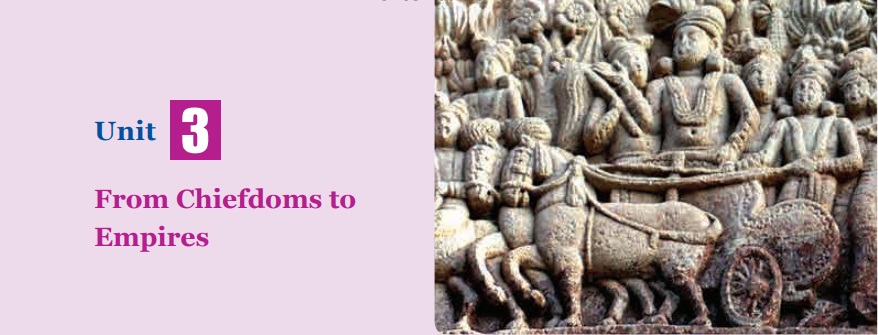
Learning Objectives
• To know the factors responsible
for the rise of Janapadas and Mahajanapadas.
• To understand the evolution of
Indian polity from Chiefdoms to Kingdoms.•To recall the greatness of Mauryan
Empire.
• To learn the main features of the
administration and the nature of the society & economy during that time.
• To gain the knowledge on Ashoka’s
policy of Dhamma.
•To examine the causes for the
decline of Mauryan Empire.VI
Importance of Sixth Century BC
(BCE)
During the sixth Century BC (BCE) many
territorial states emerged. This Led to the transformation of socio – economic
and political life of the people in the Gangetic plains. A new intellectual
awakening began to develop in northern India. Mahavira and Gautama Buddha
represented this new awakening.
Role of iron in a changing
society
Iron played a significant role in this
transformation of society. The fertile soil of the Gangetic Valley and the use
of iron ploughshares improved agricultural productivity. In addition, iron
facilitated craft production. Agrarian surplus and increase in craft products
resulted in the emergence of trading and exchange centres. This in turn paved
the way for the rise of towns and cities. Thus, knowledge in the use of iron
gave Magadha an advantage over other Mahajanapadas. Thus the Magadha could
establish an empire of its own.
Gana - sanghas and Kingdoms
There were two kinds of government in north
India during the sixth century BC (BCE)
* Gana
- sanghas – non monarchical states.
* Kingdoms
- monarchies
The term ‘gana’ means ‘people of equal status’. ‘Sangha’ means
‘assembly’. The gana - sanghas covered a small geographical area ruled by an
elite group. The gana sanghas practiced egalitarian traditions.
A ‘kingdom’ means a territory ruled by a king or queen. In a kingdom
(monarchy), a family, which rules for a long period becomes a dynasty. Usually
these kingdoms adhered to orthodox Vedic traditions.
Janapadas and Mahajanapadas
Janapadas were the earliest gathering places of
men. Later, Janapadas became republics or smaller kingdoms. The
wide-spread use of iron in Gangetic plain created conditions for the formation
of larger territorial units transforming the janapadas into Mahajanapadas.
Sixteen Mahajanapadas (“Great
Countries”)
Sixteen Mahajanapadas dotted the Indo-Gangetic
plain in the sixth century BC (BCE). It was a transition from a seminomadic
kinship - based society to an agrarian society with networks of trade and
exchange. Hence an organized and a strong system of governance required a
centralised state apparatus.
16 Mahajanapadas
Anga, Magadha, Vajji, Malla, Kasi, Kuru, Kosala, Avanti, Chedi,
Vatsa,Panchala, Machcha, Surasena, Assaka,Gandhara and Kamboja
There were four major
Mahajanapadas They were:
•
Magadha in Bihar
•
Avanti in Ujjain
•
Kosala in Eastern Uttar Pradesh and
•
Vatsa in Kausambi, Allahabad.
Among
the four Mahajanapadas, Magadha emerged as an empire.
The Causes for the
Rise of Magadha
*
Magadha was located on the lower part of the Gangetic plain. The plain was fertile
which ensured the rich agricultural yield. This provided regular and
substantial income to the state.
*
The thick forests supplied timber for construction of buildings and elephants
for army.
*
Abundance of natural resources especially iron enabled them to equip themselves
with weapons made of iron.
*
Growing trade and commerce facilitated movement of people as well as settlement
of people in centres of arts and crafts.
*
The outcome was urbanization and emergence of Magadha as an empire.

Dynasties of
Ancient Magadha
Four
dynasties ruled over Magadha Empire.
*
The Haryanka dynasty
*
The Shishunaga dynasty
*
The Nanda dynasty
*
The Maurya dynasty
Haryanka Dynasty
Magadha’s
gradual rise to political supremacy began with Bimbisara of Haryanka dynasty.
Bimbisara
extended the territory of Magadhan Empire by conquests and by matrimonial
alliances with Lichchhavis, Madra and Kosala. His son Ajatasatru, a
contemporary of Buddha, convened the first Buddhist Council at Rajagriha.
Udayin, the successor of Ajatasatru, laid the foundation of the new capital at
Pataliputra.
Shishunaga Dynasty
Haryanka
dynasty was succeeded by the Shishunaga dynasty. Kalasoka, a king of Shishunaga
dynasty, shifted the capital from Rajagriha to Pataliputra. He convened the
second Buddhist Council at Vaishali.
Nanda Dynasty
Nandas
were the first empire builders of India. The first Nanda ruler was Mahapadma.
Mahapadma Nanda was succeeded by his eight sons. They were, known as Navanandas
(nine Nandas). Dhana Nanda, the last Nanda ruler, was overthrown by
Chandragupta Maurya.
Nalanda - UNESCO
World Heritage Site.
Nalanda was a large Buddhist monastery in ancient kingdom of Magadha.
It became the most renowned seat of learning during the reign of Guptas. The
word Nalanda is a Sanskrit combination of three words Na + alam + daa meaning
“no stopping of the gift of knowledge”.
Mauryan Empire
Sources
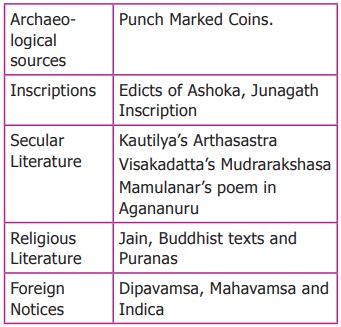
Megasthenese
He was the ambassador of the Greek ruler, Seleucus, in the court
of Chandra Gupta. He stayed in India for 14 years. His book Indica is one of
the main sources for the study of Mauryan Empire.
Mauryan Empire – India’s First
Empire
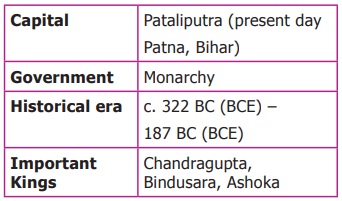
Grandeur of Pataliputra
The
great capital city in the Mauryan Empire, which had 64 gates to the city with
570 watch towers.
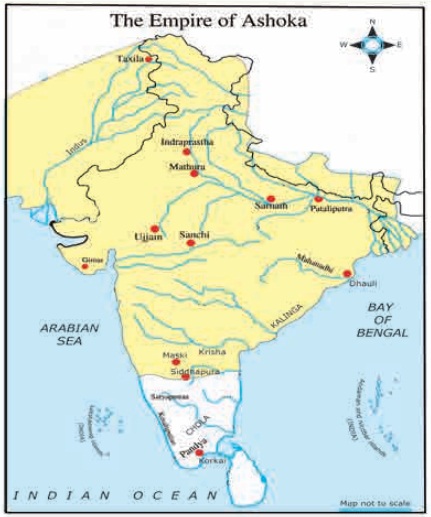
Chandragupta Maurya
The Mauryan Empire was the first largest empire
in India. Chandragupta Maurya established the empire in Magadha.
Bhadrabahu, a Jain monk, took Chandragupta
Maurya to the southern India.
Chandragupta performed Sallekhana (Jaina
rituals in which a person fasts unto his death) in Sravanbelgola
(Karnataka).
Bindusara
Real name of Bindusara was Simhasena. He was
the son of Chandragupta Maurya. Greeks called Bindusara as Amitragatha, meaning
‘slayer of enemies’. During Bindusara’s reign Mauryan Empire spread over large
parts of India. He appointed his son Ashoka as a governor of Ujjain. After his
death, Ashoka ascended the throne of Magadha.
Ashoka
Ashoka was the most famous of the Mauryan
kings. He was known as ‘Devanam Piya’ meaning ‘beloved of the Gods’.
Ashoka fought the Kalinga war in 261 BC (BCE).
He won the war and captured Kalinga.
The horror of war was described by the king
himself in the Rock Edict XIII.
“Ashoka
shines and shines brightly like a bright star, even unto this day”- H. G. Wells , Historian
Lion Capital of Ashoka
The
Emblem of the Indian Republic has been adopted from the Lion Capital of one of
Ashokas pillars located at Sarnath. The wheel from the circular base, the
Ashoka Chakra is a part of the National Flag
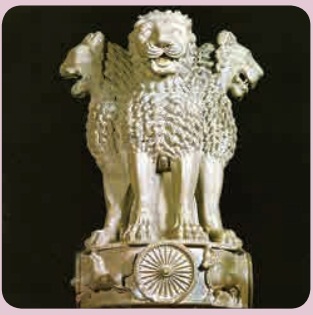
Chandasoka (Ashoka, the wicked)
to Dhammasoka (Ashoka the righteous)
After the battle of Kalinga, Ashoka became a
Buddhist. He undertook tours (Dharmayatras) to different parts of the country
instructing people on policy of Dhamma. The meaning of Dhamma is explained in
Ashoka’s – Pillar Edict II
It contained the noblest ideas of humanism,
forming the essence of all religions.
He
laid stress on
* Compassion
* Charity
* Purity
* Saintliness
* Self-control
* Truthfulness
* Obedience and
respect for parents, preceptors and elders.
Ashoka sent his son
Mahinda and Sanghamitta to Srilanka to propagate Buddhism. He also sent
missionaries to West Asia, Egypt, and Eastern Europe to spread the message of
Dhamma. The Dhamma-mahamattas
were a new cadre of officials created by Ashoka. Their job was to spread dhamma
all over the empire. Ashoka held the third Buddhist Council at his capital
Pataliputra.
Edicts of Ashoka
The 33 Edicts on the pillars as well as
boulders and cave walls made by the Emperor Ashoka, describe in detail Ashoka’s
belief in peace, righteousness, justice and his concern for the welfare of his
people.
An
Edict is an official order or proclamation issued by a person in authority or a
king.
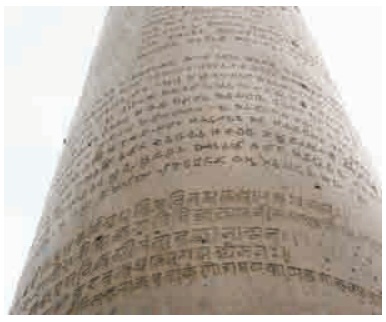
The script of the inscriptions
At
Sanchi – Brahmi
At
Kandahar – Greek and Aramaic
At
North Western part – Kharoshthi
The Rock Edicts II and XIII of Ashoka refer to
the names of the three dynasties namely Pandyas, Cholas, the Keralaputras and
the Sathyaputras.
Mauryan Administration
Centralized
administration
King
* The king was the
supreme and sovereign authority of the Mauryan Empire.
* Council of
ministers known as mantriparishad
assisted the King. Assembly of ministers included a Purohit, a Senapathi, a
Maha mantri and the Yuvaraja.
* King had an
excellent spy system.
Revenue system
* The land was the
most important source of revenue for the state. Ashokan inscription at Lumbini
mentions bali and bagha as taxes collected from people. The land tax (bhaga)
collected was 1/6 of the total produce.
* Revenue from taxes
on forests, mines, salt and irrigation provided additional revenue to the
government.
* Much of the State
revenue was spent on paying the army, the officials of the royal government, on
charities and on different public works such as irrigation project, road
construction etc.
Judicial System
* The king was the
head of the Judiciary. He was the highest court of appeal.
* King appointed many
judges subordinate to him. The punishments were harsh.
Military Administration
The king was the
supreme commander of the army.
A board of 30
members divided into six committees with five members on each, monitored
* Navy
* Armoury (
transport and supply)
* Infantry
* Cavalry
* The war chariots
* The war elephants
Municipal Administration (Cities and Towns)
* Board of 30
members divided into six committees. Each had 5 members to manage the
administration of the city.
* Town
administration was under Nagarika. He was assisted by Sthanika and Gopa.
The Junagarh
/ Girnar Inscription of Rudradaman recordsthat the construction of a water
reservoir known as Sudarshana Lake was begun during the time of Chandragupta
Maurya and completed during Ashoka’s reign.
Currency
Money was not only used for trade; even the
government paid its officers in cash. The punch marked silver coins (panas)
which carry the symbols of the peacock, and the hill and crescent copper coins
called Mashakas formed the imperial currency.
Trade and Urbanization
Trade flourished particularly with Greece
(Hellenic) Malaya, Ceylon and Burma. The Arthasastra refers to the regions
producing specialized textiles – Kasi (Benares), Vanga(Bengal), Kamarupa
(Assam) and Madurai in Tamilnadu.
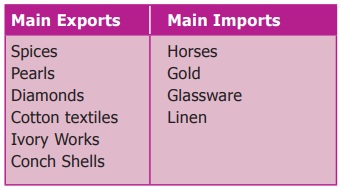

Mauryan Art and Architecture
Mauryan art can be
divided into two
Indigenous Art – Statues
of Yakshas and Yakshis
Royal Art – Palaces
and Public buildings
- Monolithic Pillars
- Rock cut Architecture
- Stupas
Yakshas
were deities connected with water, fertility, trees, the forest and wilderness.
Yakshis were their female counterpart.
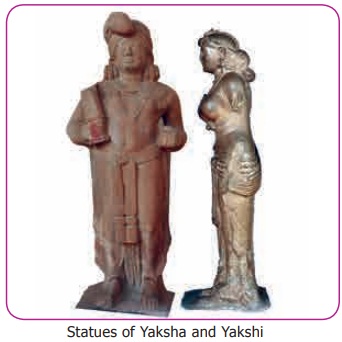
Stupas
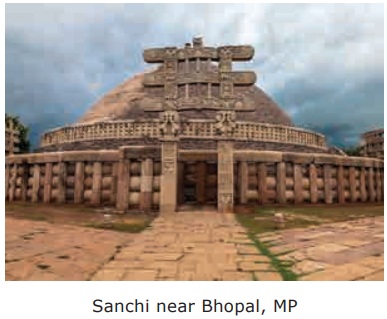
A Stupa is a semi – spherical dome like
structure constructed on brick or stone. The Buddha’s relics were placed in the
centre of the dome.
Monolithic Pillar – Sarnath
The crowning element in this pillar is Dharma
chakra.
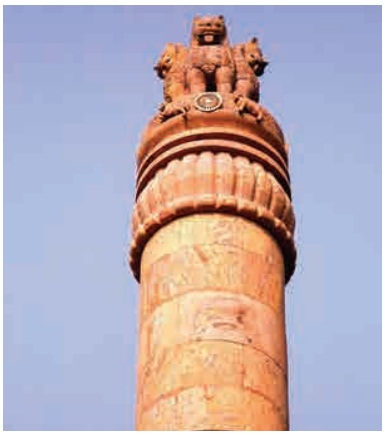
Beginning of Rock cut Architecture Rock – Cut Caves of Barabar and Nagarjuna
Hills
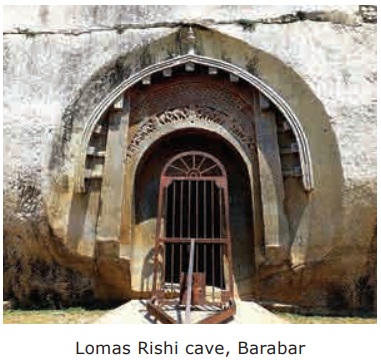
There are several caves to the north of Bodh
Gaya. Three caves in Barabar hills have dedicativeinscription of Ashoka. And
three in Nagarjuna hills have inscriptions of Dasharatha Maury (grand son of
Ashoka).
Reasons for the
Decline of the Mauryan Empire
*
Ashoka’s successors were very weak.
*
Continuous revolts in different parts of the empire.
*
Invasion by the Bactrian Greeks weakened the empire.
*
Last Maurya ruler Brihadratha was killed by his commander Pushyamitra Sungha
who established Sungha dynasty.
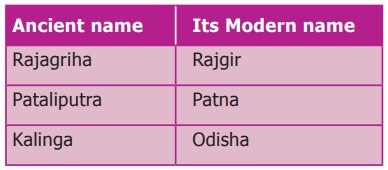
Elswhere in the world
The Great Wall of
China
It is an ancient series of fortification. During third century
BC (BCE) emperor Qin-ShHuang linked these walls on Northern border to protect
his empire

Temple of Zeus at
Olympia
An ancient temple in Olympia, Greece, dedicated to the god Zeus,
constructed durinfifth century BC (BCE), It is one of the seven wonders of the
ancient world.
Summary
*
Sixth century BC (BCE) forms an important landmark as it witnessed the
emergence of sixteen Mahajanapadas.
*
Among the sixteen Mahajanapadas, Magadha emerged as an empire.
*
Magadha was ruled by four dynasties- The Haryanka, the Shishunaga, the Nanda
and the Maurya dynasty.
*
Chandragupta Maurya established the Mauryan empire.
*
Ashoka was the most famous of the Mauryan kings.
*
Ashoka’s pillar and Rock Edicts enlighten us on his ideas of Dhamma.
GLOSSARY
Egalitarian –a
person who advocates the principle of equality for all. (சமத்துவம்)
Monastery –a
building in which monks live and worship. (மடாலயம்)
Treatise –a written
work dealing systematically with a subject. (ஆய்வுக்கட்டுரை)
Horror –a
feeling of fear and anxiety (பேரச்சமும் நடுக்கமும்)
Refrences
1.
Romila Thapar, Early India: From the Origins to 1300 AD. Penguin, 2015.
2.
R.S. Sharma, India's Ancient past. Oxford University Press, 2005.
3.
Upinder Singh, A History of Ancient and Early Medieval India. Pearson, 2008
ICT CORNER
Histroy from Chiefdoms to Empires
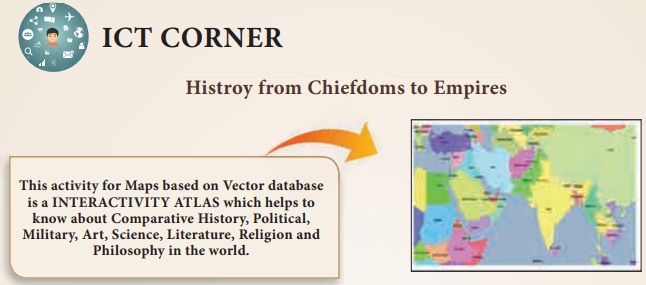
This
activity for Maps based on Vector database is a INTERACTIVITY ATLAS which helps
to know about Comparative History, Political, Military, Art, Science,
Literature, Religion and Philosophy in the world.
Step
– 1: Open the Browser and type the URL given (or) Scan the QR Code.
Step
- 2 : World History Atlas page will appear.
Step-3
: You will enter any kingdom period or political period (ex. Magadha Empire).
Step-4
: You will get vector database map.

URL
Related Topics